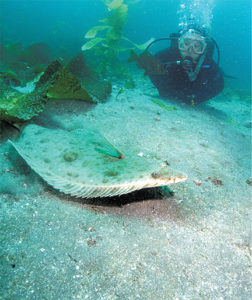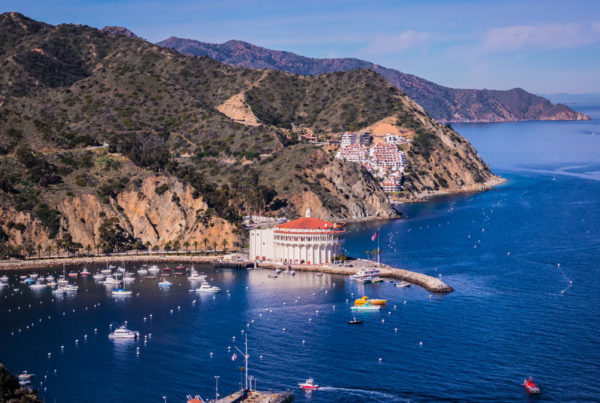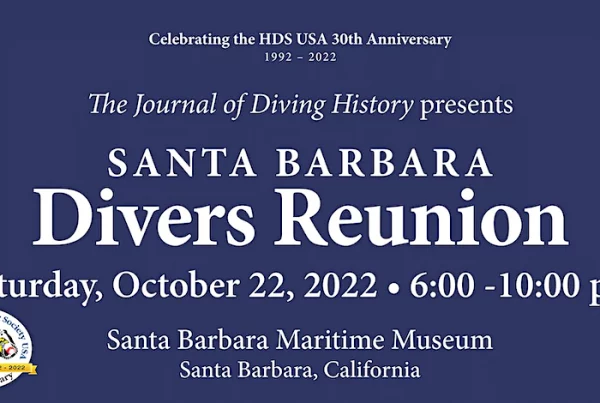 When the crowds of summer have gone, divers can safely get into nooks, crannies and reefs of Isthmus Cove that are usually jammed with pleasure boaters during summer months. Perhaps the most popular mooring area is Cherry Cove on the west side of Isthmus Cove. There are more than 100 moorings in the cove (controlled by the Isthmus Harbor Patrol) and a Boy Scout Camp on shore. On the north side of the cove is the popular dive site known as Lion Head. On the south side of Cherry Cove, however, there is a wonderful reef, but because it’s near an area of heavy boating activity, it is rarely dived. It typically has lower visibility than Lion Head and Isthmus Reef, but what it lacks in water clarity it makes up for in marine life and game.
When the crowds of summer have gone, divers can safely get into nooks, crannies and reefs of Isthmus Cove that are usually jammed with pleasure boaters during summer months. Perhaps the most popular mooring area is Cherry Cove on the west side of Isthmus Cove. There are more than 100 moorings in the cove (controlled by the Isthmus Harbor Patrol) and a Boy Scout Camp on shore. On the north side of the cove is the popular dive site known as Lion Head. On the south side of Cherry Cove, however, there is a wonderful reef, but because it’s near an area of heavy boating activity, it is rarely dived. It typically has lower visibility than Lion Head and Isthmus Reef, but what it lacks in water clarity it makes up for in marine life and game.
This is a good spot for lobster. Jumbled boulders drop off steeply to a sand bottom at 70 feet. The boulders have plenty of deep crevices filled with legal-sized lobster.
Farther to the south, toward the tiny town of Two Harbors, seems to be a bit better. In the spring this is a breeding ground for white sea bass. They move up into the shallows of the kelp forest and pair up in 20 to 30 feet of water. To even consider approaching a skittish white sea bass you have to be a freediver with exceptional skill.
Other game at this location includes sheephead and calico bass, although most are small. Better for the scuba diving spearfisher would be the halibut that frequent Cherry Cove itself. Just always be aware of boat traffic hazards.
Photographers and sightseers are best to stay out of the cove and concentrate on the rocks and the sand that drops off into the deep sections of Isthmus Cove. There are a lot of blue-banded gobies flitting about the rocks. Their small size and cautious nature make them challenging macro photo subjects. We’ve noticed a lot of juvenile sheephead in this location recently.
As an underwater photographer, you might find yourself drawn deeper across the sand near reef fringes to the large bull kelp stretching out across the sand. It’s usually only found from central California northward. Unlike our home giant kelp which uses a multitude of small gas bladders to support a tall stalk with many “leaves,” bull kelp uses a single grapefruit-sized bladder anchored to the bottom by a single long strand. Five or six very long, broad leaves then stretch from the branches away from the bladder. In the current, the big leaves stretch out like a mermaid’s long flowing hair. It is an impressively large algae with interesting textures and qualities of light absorption that make for interesting photos. Backlight the kelp with the sun and overexpose the kelp itself a half to a full stop to bring out the subtle textures. An interesting fact about bull kelp is the entire algae is edible. And it is very nutritious. You can dry it and snack away, pickle it, make relish, and salads, or even candy treats. Go online for recipes and cook up what you’d like!
Reaching the multitude of dive sites of Catalina Island, especially the dozens in around Isthmus Cove, is quite easy. There are several dive charter boats that visit the area from a number of mainland landings as well as out of Avalon on Catalina Island itself.
If you choose to visit here in your own boat, there are a lot of moorings to choose from during the off-season. Mooring fees are collected by the harbormaster.
For both non-diving and diving visitors there are other fun options in the Isthmus area in the tiny town of Two Harbors. Kayaking is good inside the normally calm Isthmus Cove as well as Cherry Cove. At Two Harbors there is a small dive shop with air fill station, a small general store and a restaurant with a bar. If you want to try a completely different island experience, consider a stay at the Banning House, a superb B&B from the old Banning estate. In addition, you can camp at the Isthmus and rent kayaks and other water sports equipment depending on the time of year. For more information, visit visitcatalinaisland.com.
At-A-Glance
Skill Level: All
Location: West side of Isthmus Cove, the rocky point off the south side Cherry Cove. GPS N33°27.021’, W118°29.971’
Access: Boat only
Entry and Exit: Calm and easy
Depth Range: 20 to 80 feet. Shallow area good for snorkeling.
Visibility: Fair, clearer water at nearby sites.
Photography: Fair
Hunting: Fair for halibut and white bass and lobster.
Cautions: Boat traffic. Avoid diving here during the summer or during busy holidays.
Restrictions: Lobstering is prohibited west of Lionhead Point on the north end of Cherry Cove. Diving under the mooring buoys is prohibited.









